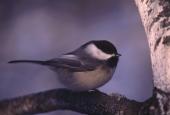
Chickadees belong to the family Paridae, with approximately fifty-three species worldwide. These small perching birds are found on all continents except Australia and Antarctica. Of the seven species native to North America, two are common in Saskatchewan and one is a rare, irregular visitor. All chickadees are small, active birds with relatively long tails and short, strong bills. Mostly non-migratory, they nest in tree cavities. The black-capped chickadee (Parus atricapillus) is the best-known Saskatchewan chickadee, common in the southern boreal forest, the parklands, and the Cypress Hills. Its neat uniform of gray back, black cap and bib, and pale underparts is easily recognized. Immensely social, they come readily to feed trays and will often alight on one’s hand to pick up food. One of the most admired local birds, they are adaptable, fearless, skilled at evading predators, and capable of withstanding the rigours of a prairie winter.
The boreal chickadee (P. hudsonicus) inhabits the boreal forest to the northern limits of the province. In winter it occasionally moves south to the parklands, but is almost never seen on the prairies. Partial to coniferous trees, it is somewhat more elusive and less gregarious than its black-capped cousin. It is easily recognized by its mouse-brown cap, brown flanks, and rather nasal chick-a-dee-dee. The mountain chickadee (P. gambeli), similar to the black-capped chickadee but with a striking white eyebrow line, is a rare visitor from the Rocky Mountains. Two summer records in the Cypress Hills (1980, 1989) suggest the possibility of breeding in that area.
J. Frank Roy